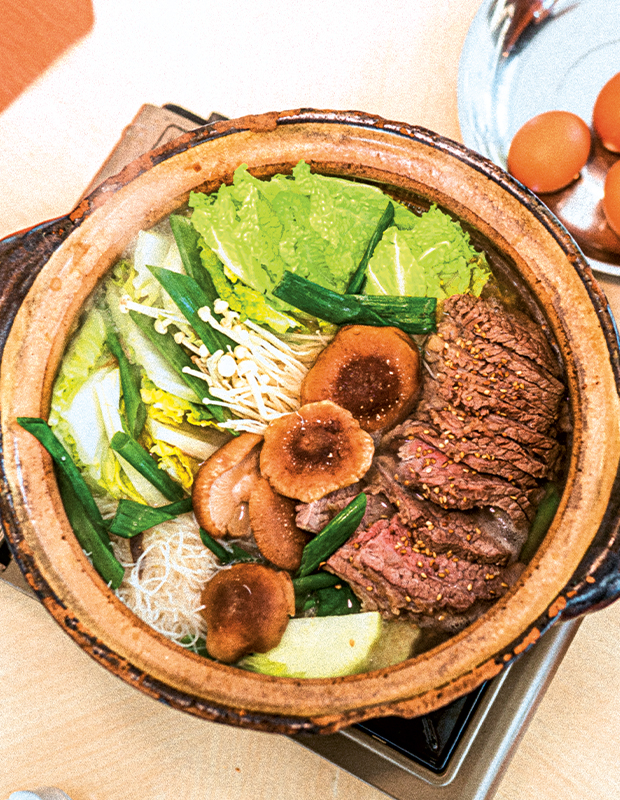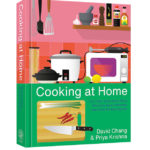Recipe
June 10, 2022
Sukiyaki

 David: I need to make sukiyaki more often. It’s an easy, interactive Japanese dish of meat, vegetables and noodles that’s cooked tableside — it’s always a crowd-pleaser. Often, sukiyaki is cooked over a portable stove in the centre of the dinner table, but if you don’t have one, you can cook the broth in a heavy pot and bring it to the table; the meat and the vegetables will still cook for a while in the residual heat.
David: I need to make sukiyaki more often. It’s an easy, interactive Japanese dish of meat, vegetables and noodles that’s cooked tableside — it’s always a crowd-pleaser. Often, sukiyaki is cooked over a portable stove in the centre of the dinner table, but if you don’t have one, you can cook the broth in a heavy pot and bring it to the table; the meat and the vegetables will still cook for a while in the residual heat.
Directions
Yield: Serves 4
MAKE BRISKET BROTH
- David: Start with a big pot. Add enough water to cover the meat once you put it in (don’t put it in yet), and then season your water. With salt, yes, but also with whatever other seasonings you’re looking to add. Season early and season a lot — the water should taste salty but not like the ocean (you’re not cooking pasta). Yes, you should be tasting your water before you add any meat! If you underseason severely at the beginning, you’re screwed — you’ll never get to the seasoning level you want. But if you overseason, you’re really screwed. You can always add, but you can’t take away. My solution to overseasoning is usually to add more liquid or to double the recipe, but the key to avoiding all this is to keep tasting and adjusting the seasoning as you go.
- Once you’re at a seasoning level you like, add the meat and bring the water to a boil. Cooking at higher heat takes less time than cooking at lower heat, and some meats, like chicken, will take less time than others, like beef. Remember, we’re not talking about a silky, just-done poach here. This is about boiling until tough cuts tenderize. Cut the meat into small pieces or cover the pot if you want it to cook faster. When you’re cooking over medium-high to high heat, watch to make sure the contents don’t boil over, which might happen in a very full pot, or that you’re not scorching the bottom of the meat. Also, when cooking on higher heat, water evaporates more quickly. That’s why, in the first 75 per cent of cooking time or so, it’s important to keep adding water as needed to maintain the liquid level — and therefore seasoning level — you started with.
- As you’re cooking, occasionally skim the fat with a spoon. If you don’t want to babysit your pot, lower the heat. The meat will take longer to cook but you can walk away for longer without worrying if the water is evaporating too quickly and your meat is getting scorched. My general rule of thumb for any meat is that it’s done when you press your finger into it and it leaves an indent while also springing back a little.
- Once the meat is done (less tough cuts like chicken could take less time, more like an hour; tougher cuts like chuck and pork shoulder may take two hours–plus), take it out, bring the broth to a simmer if it isn’t already, toss in whatever additional seasonings and aromatics or vegetables you’d like, then add back the meat at the end if you’re making a soup or stew. Otherwise, you’ve got broth and meat to do whatever you want with.
MAKE SUKIYAKI
- David: Fill a wide pot or Asian clay pot with a fair amount of brisket broth, enough to drop stuff into and cook in, and season it with a few shakes each of soy sauce, mirin and a little bit of sweetener, like agave syrup or honey. Cover and let the broth warm up on low heat until all the seasonings taste harmonious.
-
In the meantime, set up your mise en place: a bunch of thin slices of cooked brisket and a generous amount of thinly sliced raw vegetables — cabbage, white or yellow onion, scallions and mushrooms all work well (“thinly sliced” is important here because it means quick cooking).
-
To make a dipping sauce, beat one raw egg in a bowl and season with ponzu, or a mix of soy sauce and lime juice. The traditional version is just the egg, but I like to season it.
-
You and your fellow eaters can then add whatever vegetables and meat you want to the pot — they all cook pretty quickly and the brisket is already cooked, so you’re mainly warming it up in the broth — then pluck out what you want and eat. At the end, set the broth back over heat, bring to a simmer and cook a few handfuls of glass noodles in it to enjoy as a last course.
Excerpted from Cooking at Home by David Chang and Priya Krishna. ©2021 David Chang. Photography by Horatio Baltz. Illustrations by Stanley Chow. Published by Clarkson Potter Publishers, an imprint of Random House, a division of Penguin Random House. New York. Reproduced by arrangement with the Publisher. All rights reserved.


